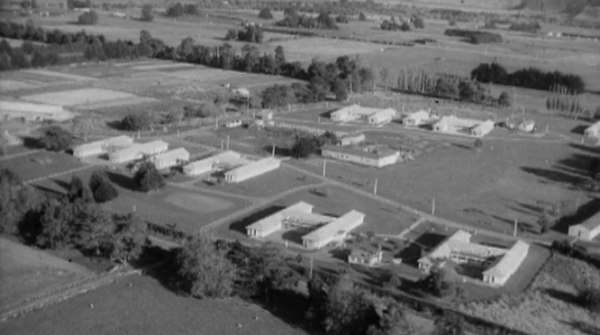Chapter 1: Introduction
Disabled children, young people and adults – ‘Out of sight, out of mind’
8. For the 61 years that the Kimberley Centre was open, the institution had a significantly harmful impact on the lives of many of the disabled people who lived there. The evidence received by the Inquiry about severe abuse and neglect at the Kimberley Centre makes for sobering reading. The Inquiry acknowledges the bravery and perseverance of survivors in bringing this evidence to the Inquiry. The Aotearoa New Zealand public must acknowledge and understand what happened at the Kimberley Centre to ensure it is never allowed to happen again.
9. Te Iwi Muaūpoko are the mana whenua of the rohe that includes the Kimberley Centre. The Kimberley Centre was located on the outskirts of Taitoko Levin in an isolated rural setting. It had a mixture of old colonial buildings and dormitory barrack-style buildings[2] designed for short-term accommodation. It was one of four large psychopaedic institutions in Aotearoa New Zealand that housed thousands of disabled children, young people and adults during its 61-year lifespan. The term psychopaedic is a uniquely Aotearoa ew Zealand term. It is a composite of ‘mind’ and ‘child’. It was coined in the early 1960s by Dr Blake Palmer, Director of Mental Health, to describe people with a learning disability to distinguish them from people who were mentally ill (terms used at the time).[3]

10. The Kimberley Centre was the largest psychopaedic hospital in the Southern Hemisphere. The other psychopaedic institutions were Templeton Farm Colony, later renamed the Templeton Centre (Ōtautahi Christchurch), Braemar (Whakatū Nelson) and Māngere Hospital (Te Tonga o Tāmaki Makaurau South Auckland). Despite the existence of these four large specialist hospitals, by 1981 nearly half of Aotearoa New Zealand’s institutionalised population of people with a learning disability remained in ‘intellectual handicap’ wards within psychiatric hospitals.[4]
11. People who spent decades of their lives at the Kimberley Centre were left out of sight, out of mind. A 1964 documentary about the Kimberley Centre, One in a Thousand, stated: “The public doesn’t often see these hospital training schools as they’re called. It prefers not to think about them.”[5] The placement of disabled people at the Kimberley Centre, away from the rest of society, demonstrates overt ableism.
12. Aotearoa New Zealand can no longer avoid these issues. The Crown has said:
“The Crown’s responsibility is not to deny or diminish, it is to accept and acknowledge that abuse occurred.”[6]
This case study is an opportunity to acknowledge the abuse and neglect that survivors experienced at the Kimberley Centre.
13. The Inquiry has made significant attempts to reach out to people in the community who spent time in the Kimberley Centre, including offering specialist pathways, supported decision-making, navigators and wellbeing supports. However, the Inquiry acknowledges that it was still inaccessible for many survivors, especially people with a learning disability, for Māori survivors and for Pacific survivors of psychopaedic institutions.
14. Many survivors of the Kimberley Centre have passed away and have been unable to share their experiences. Other survivors may not have recognised their experiences as abuse due to the dehumanising environment.[7] As a result, the Inquiry received fewer statements from survivors of the Kimberley Centre than from the survivors of many other State settings the Inquiry has investigated. This case study is based on the accounts of those survivors who were able to come forward, as well as a wide range of evidence, including thousands of documents, witness observations and accounts by family members.
Footnotes
[2] Transcript of evidence of Paul Milner at the Inquiry’s Ūhia te Māramatanga Disability, Deaf and Mental Health Institutional Care Hearing, (Royal Commission of Inquiry into Abuse in Care, 12 July 2022, page 113); Witness statement of David Newman (31 May 2022, para 5.6).
[3] Mirfin-Veitch, B & Stewart, C, The impact of deinstitutionalisation on the families of the Kimberley Centre residents (Donald Beasley Institute, 2008, page 2).
[4] Milner, P, An examination of the outcome of the resettlement of residents from the Kimberley Centre (Donald Beasley Institute, 2008, page 24).
[5] New Zealand National Film Unit, One in a Thousand (1964), https://www.nzonscreen.com/title/one-in-a-thousand-1964/availability.
[6] Transcript of opening statement by the Crown at the Inquiry’s Ūhia te Māramatanga Disability, Deaf and Mental Health Institutional Care Hearing (Royal Commission of Inquiry into Abuse in Care, 11 July 2022, page 15).
[7] Witness statement of Paul Milner (20 June 2022, para 3.19).
